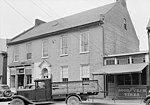Romney Academy was an educational institution for higher learning in Romney, Virginia (now West Virginia). Romney Academy was first incorporated by the Virginia General Assembly on January 11, 1814, and was active until 1846 when it was reorganized as the Romney Classical Institute. In addition to the Romney Classical Institute, Romney Academy was also a forerunner institution to Potomac Seminary. Romney Academy was one of the earliest institutions for higher learning within the present boundaries of the state of West Virginia.
With the growth of settlement in Pearsall's Flats, which was later the location of Romney, the need for educational facilities became apparent and the community began plans for the establishment of schools and churches. A log structure, which served as both a school and a church, was built at Pearsall's Flats around 1752 near Fort Pearsall. To provide for a teacher's payment, a form was circulated around Romney and each parent indicated on the paper how many of their children would attend the school and the type of payment the teacher would expect. By the time Romney was surveyed by Thomas Fairfax, 6th Lord Fairfax of Cameron laid out the town of Romney in 1762, the log school was still in existence. That year, a stone school building was erected on the site to the immediate north of the old Hampshire County Courthouse and became known as Romney Academy.
Local education, including Romney Academy, continued to depend exclusively upon subscriptions until 1810 when the Virginia General Assembly passed what was known as the "Literary Fund". The assembly first incorporated Romney Academy on January 11, 1814. In 1817, the assembly passed a bill for the incorporating the trustees of Romney Academy. The Virginia General Assembly reincorporated Romney Academy on February 11, 1818, and on March 25, 1820. In 1820, as a result of a movement and debate for higher education by the Romney Literary Society, Romney Academy incorporated classical studies into its curriculum, thus making it the first institution of higher education in the region.
By 1831, Romney Academy had outgrown its facilities, and the Romney Literary Society was given authorization to raise monies from a lottery to build a new school building. The society successfully raised the funds, and in 1845 bids were called for the construction of a new school building. On December 12, 1846, the Virginia General Assembly empowered the Romney Literary Society to establish a seminary for learning at the academy. That same year, a new brick building was constructed for the academy and for the library of the society; the building now serves as the central unit of the administration building of the West Virginia Schools for the Deaf and Blind.
Romney Academy was administered under the leadership of scholarly Englishman Dr. Henry Johnston, who was succeeded by Presbyterian Reverend and historian Dr. William Henry Foote. Foote introduced courses in theology into the school's curriculum. As the school's popularity grew and knowledge of its curriculum under Dr. Foote spread, Romney Academy began to attract students from beyond the South Branch Potomac River valley region. Other educators at Romney Academy during its early years were E. W. Newton, Silas C. Walker, Thomas Mulledy, and Samuel Mulledy. Thomas and Samuel Mulledy each later served as presidents of Georgetown University in Washington, D.C.








